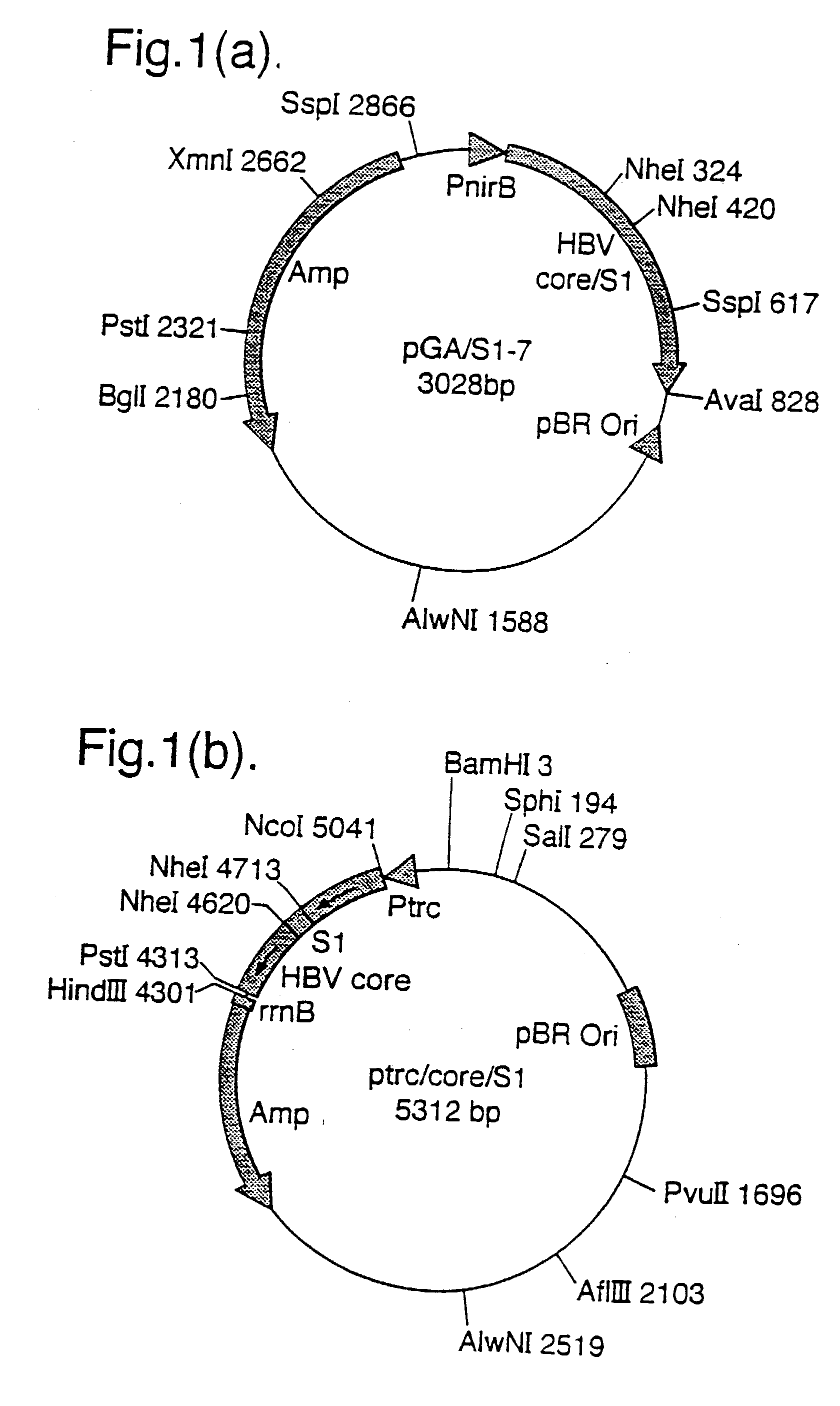Designing immunogens
a technology of immunogens and antibodies, applied in the field of immunogen design, can solve the problems of unbalanced t-helper (th) cell response, antibody by itself cannot clear intracellular, and the number of activated th1 cells is believed to be inadequate to clear the virus
- Summary
- Abstract
- Description
- Claims
- Application Information
AI Technical Summary
Benefits of technology
Problems solved by technology
Method used
Image
Examples
example 2
Evaluation of the IEG Subclass Response Against HBV Core Protein `e1`-Loop in Mice Immunised with HBV Core or HBV Core Truncated at Amino Acid 146
[0151] 1 Materials and Methods
[0152] 1.1 Immunogens
[0153] 1.1.1 IBV Core Protein (Core)
[0154] HBV Core protein (amino acids 1-185) was expressed in Escherichia coli bacteria (strain HB 101) transformed with the plasmid ptrc / Core. This was constructed as follows:
[0155] A 636 bp Nco I / Pst I digested, pGA-I (FIG. 21) PCR fragment (which encodes for the full length Core protein) was subcloned into a 4583 bp Nco I / Pst I fragment of pKK233.2 (ptrc, Pharmacia, Sweden). This generated a ptrc / Core plasmid, which expressed HBV Core under the trc promoter (see FIG. 12).
[0156] Following lysis of the bacterial cells, Core particles were purified by buoyant density centrifugation, using sucrose gradients (15-45%). They were dialysed against PBS for 4h and then 18h and concentrated using Aquacide.TM. (Calbiochem Cat. No. 17851). Core protein was quantifi...
example 3
Properties of Core-S1.sub.146, an HBc Derivative with a pre-S1 Insert in the e1 Loop and a Truncation at Position 146
[0207] The Core-S1.sub.146 product was provided by a collaborator of the inventors, Dr Paul Pumpens of the University of Latvia. The product was analysed by the inventors to determine whether it has a particulate structure and whether it induces a Th1 or Th2 dominated response using the methods described above in Examples 1 and 2.
[0208] The Core-S1.sub.146 was found to be exclusively particulate (FIG. 25) and to induce an IgG1 (Th2) dominated response against the pre-S1 insert at both day 14 post one dose (FIG. 26) and at day 28 post two doses (FIG. 27). This indicates that the presence of a particulate structure by itself is not responsible for inducing a Th1 response.
example 4
Evaluation of 12G Subclass Response Against Core Having an HBV pre-S2 (Amino Acids 139-174) `e1`--Loop Insert
[0209] 1. Materials and Methods
[0210] 1.1 Immunogens
[0211] Hepacore PS2 is a recombinant full length hybrid HBcAg containing the pre-S2 sequence of HBsAg (amino acids 139-174) inserted into the e1 loop between amino acids 79 and 80. Hepacore PS2 was purified by sucrose density gradient centrifugation following expression from E. coli bacteria (HB 101 strain) transformed with the plasmid ptrc / core / S2. This was constructed as follows:
[0212] Plasmid pGA / S2 (a schematic representation is shown in FIG. 18a) was constructed by subcloning a 96 bp Nhe I PCR fragment which encodes pre-S2 (139-174 amino acids, ayw subtype) into the Nhe I site of pGA-1 (a plasmid which encodes core) (see FIG. 21). A 728 bp PCR fragment from pGA / S2 (which encodes core-S2) was digested with Nco I / Pst I and was subcloned into the Nco I / Pst I site of the vector pKK233-2 (ptrc, Pharmacia, Sweden) precut with...
PUM
| Property | Measurement | Unit |
|---|---|---|
| diameter | aaaaa | aaaaa |
| time | aaaaa | aaaaa |
| retention time | aaaaa | aaaaa |
Abstract
Description
Claims
Application Information
 Login to View More
Login to View More - R&D
- Intellectual Property
- Life Sciences
- Materials
- Tech Scout
- Unparalleled Data Quality
- Higher Quality Content
- 60% Fewer Hallucinations
Browse by: Latest US Patents, China's latest patents, Technical Efficacy Thesaurus, Application Domain, Technology Topic, Popular Technical Reports.
© 2025 PatSnap. All rights reserved.Legal|Privacy policy|Modern Slavery Act Transparency Statement|Sitemap|About US| Contact US: help@patsnap.com



